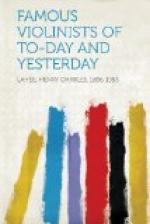These anecdotes, told by an effusive admirer, seem rather ridiculous, but when Paganini visited Genoa, and Sivori was six years old, the virtuoso took a great deal of interest in the little fellow and gave him lessons. He also wrote a concerto for him, and six short sonatas with accompaniment for guitar, tenor, and ’cello, and these the young artist soon played in public. In six months Paganini left Genoa and desired to take his young pupil with him, but this was not allowed by the parents, and Sivori was placed under the tuition of Costa. Three years later Paganini returned to Genoa, and by his advice his protege was placed under M. Dellepaine, who taught him taste and expression, his lessons with Costa in technique continuing. In 1827 Sivori made a concert tour with M. Dellepaine, and visited Paris, where his playing at the Conservatoire won him great applause. He also appeared in England, after which he entered upon another serious course of study for several years, and perfected the tone which enraptured the world for so long, and at the same time he studied composition under Serra.
In 1839 his concert tours began again, and he visited Germany, Russia, Belgium, and Paris, where he played at the Conservatoire concerts and received the medal of honour.
Sivori now set out on extensive travels, and, after visiting England, proceeded, in 1846, to America, travelling through the United States, Mexico, and various parts of South America, spending eight years in these peregrinations, and amassing a considerable fortune. During this great tour he met with many adventures, frequently travelling on horseback, and at one time being at death’s door with yellow fever. On his return to Europe he shared the fate of many musicians who have achieved financial success, and lost his money by unfortunate investment, which made it necessary for him to resume his travels. He therefore visited Great Britain, Switzerland, Germany, Spain, Portugal, etc.
He was, of course, compared to many of the great violinists of his time, who all had their special merits. One criticism, in which Sivori is compared with Spohr, may be interesting: “Spohr is of colossal stature, and looks more like an ancient Roman than a Brunswicker; Sivori is the antithesis of Spohr in stature. Spohr has the severe phlegmatic Teutonic aspect; Sivori has the flashing Italian eye and variability of feature. Spohr stands firm and still; Sivori’s body is all on the swing, he tears the notes, as it were, from his instrument. Spohr’s refinement and polish have been the characteristics of his playing; in Sivori it is wild energy—the soul in arms—the determination to be up and doing—the daring impulse of youthful genius. Spohr’s playing is remarkable for its repose and finish; Sivori electrifies by the most powerful appeals to the affections.”




